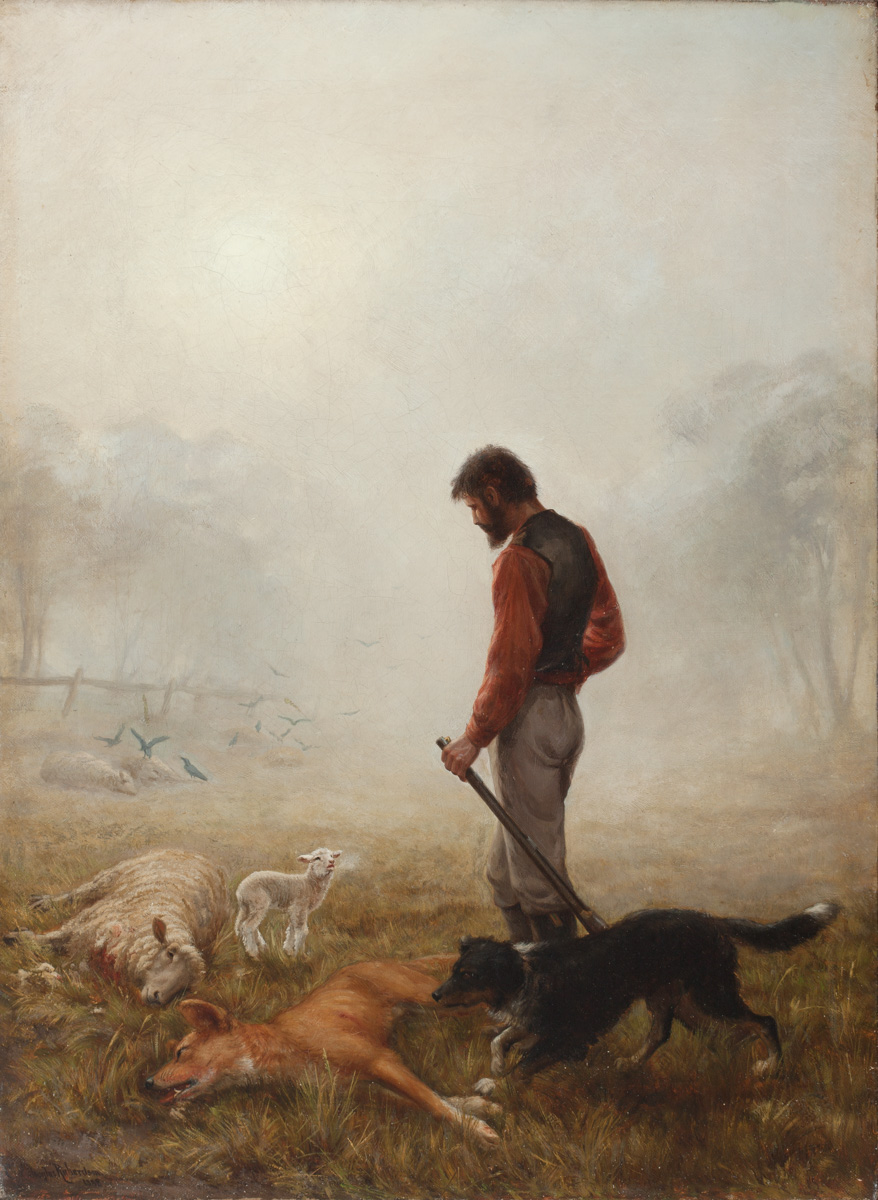The Last of the Flock: An Incident in Australia
Charles Douglas Richardson

Details
- Artist
- Charles Douglas Richardson
- Title
- The Last of the Flock: An Incident in Australia
- Year
- 1882
- Medium
- oil on canvas
- Size
- 76.2 x 50 cm
- Details
signed lower left: Douglas Richardson 1882
Sold This artwork has been sold. Please contact us for similar artworks.
Provenance
private collection, Devon, U.K. 1985
Lauraine Diggins Fine Art, Melbourne, 1988
private collection, Sydney
Exhibited
The Australian Impressionists: Their Origins & Influences, Lauraine Diggins Fine Art, Melbourne, Westpac Gallery, Victorian Art Centre, Melbourne, then St Neots, Double Bay 15 Aug - 16 September, 1988, cat. no. 15 (illus)
Literature
Astbury, Leigh The Dog in Australian Art, Art and Australia, 30 February 1997, pp. 242-251
Betley, John, Touch of our art in an old English pub, The Age, Melbourne, 4 August 1973, p. 14
Rose, Margaret, Victorian Artists: Margaret Baskerville 1861-1930 C. Douglas Richardson 1853-1932, Jones Printing Group, 1988, illus. p. 64
Further Information
Charles Douglas Richardson, close friend of Tom Roberts, Frederick McCubbin and Arthur Streeton, is one of the unsung heroes of Australian art. Moreover, Roberts’ Shearing the Rams 1890 (National Gallery of Victoria, Melbourne), McCubbin’s Down on His Luck 1889 (Art Gallery of Western Australia, Perth) and Streeton’s Golden Summer, Eaglemont
1889 (National Gallery of Australia, Canberra) are today celebrated as icons of Australian art. Richardson’s ‘The Last Of The Flock’, An Incident In Australia 1882 deserves to be among them. For it is, arguably, the first major oil painting from this group to devote itself to a major Australian pioneering subject and the great sheep industry in particular. Its title also appears to be another first, ‘The Last of the Flock’ being taken from a 1798 poem by William Wordsworth. In 1890 Streeton followed suit with ‘Still glides the stream, and shall for ever glide’, from Wordsworth’s sonnet Conclusion.
Painted in 1882, while Richardson was studying at the Royal Academy Schools in London, it is set in the Australian landscape, redolent with the times and tribulations of the early settlers. Focused on the hardships of the sheep farmer, the ennobled figure is reminiscent of a sculptural figure by Michelangelo or one from classical antiquity. Strikingly silhouetted against the silvery mist of an early foggy morning, the blood red of his shirt and the tan of the dingo are heightened by the contrasting prominently neutral colour setting. It gives the painting a directness and intensity, the narrative touching on the allegorical in the bloody collision of the native and the newcomers. The shot dingo lies dead at the shepherd’s feet, observed carefully by the faithful collie companion. In the distance, crows feed on the carnage of slain sheep, while a lamb nearby her dead mother, bleats piteously at the farmer. The lamb is the last of the flock.
As a pioneering work in this genre, ‘ The Last of the Flock’, An Incident In Australia, raises the sheep industry and physical labour to a new nobility, soon to grow in popularity in Australian art. It also draws on subjects much admired in European art. In 1880, the National Gallery of Victoria purchased Anguish by the German artist A. T. A. Schenck, showing a ewe standing protectively over the dead body of her lamb, surrounded by a threatening circle of black crows. Richardson most likely knew this painting as it was acquired before he left for England in 1881. The orphaned lamb also echoes a popular British genre subject, exemplified by Thomas Faed’s The Mitherless Bairn. Regarded as the picture of the year at the Royal Academy of 1855, it was likewise purchased by the National Gallery of Victoria in 1886. The metaphoric use of sheep in art was employed by the Pre-Raphaelites, a well known example being William Holman Hunt’s Strayed Sheep 1852, in the collection of the Tate Gallery, London. Of other animals, perhaps none is better known than Hunt’s The Scapegoat of 1854 in the Lady Lever Art Gallery, Port Sunlight.
Richardson’s interest in nationalistic subjects of bushmen and the masculine view of Australian life had its beginnings early in his career. At Melbourne’s Buonarotti Club, Richardson ‘..had laid down the law that artists should paint what was around them, and select incidents from Australian explorers and subjects of a local nature’.¹ His illustrations for McKinley’s Australian Pictorial Almanac of 1880 included Sheep Farming in Australia, Leigh Astbury noting that ‘Richardson’s drawings depict some of the most dominant pastoral and historical themes of late nineteenth-century Australian art’.²
The wool theme continued after his return to Melbourne in 1889, The Sick Shepherd being among his numerous paintings in the 9 x 5 Impression Exhibition, while a Foggy Morning was singled out by Table Talk as ‘one of the best “bits” showing’.³ Another version of The Sick Shepherd, now lost, was in the Victorian Artists’ Society March exhibition of 1890, which also included McCubbin’s A Bush Burial (Geelong Art Gallery). While Richardson’s later works are more symbolist and mystic in intent and content, his sculptures, realized or lost through want of commission, continued his ‘subjects of a local nature’. A particularly fine example was the plaster cast of The Pioneer exhibited at the Victorian Artists’ Society in 1892; and the singular public achievement, The Discovery of Gold monument was set up in marble splendour in Bendigo in 1906.
David Thomas
¹. Minutes of the Buonarotti Club, 1883-87, La Trobe Collection, State Library of Victoria, MS10977, quoted in Leigh Astbury, City Bushmen: e Heidelberg School and the Rural Mythology, Oxford University Press, Melbourne, 1985, p. 20
². Astbury, 1985, p. 60
³. Table Talk, Melbourne, 23 August 1889, p. 4 The wax sculptural relief Wind 1889, now in the National Gallery of Australia, was in the same 9 x 5 exhibition, being an allegorical reference to the heat and oppression of an Australian summer.
